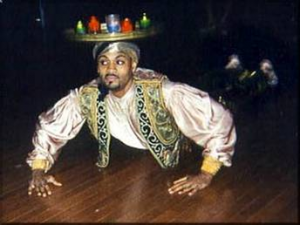Choufou El Arbiyya: Tunisian Women’s Dance
Tunisian women have a solidarity stronger than in most other countries. In many countries, the strongest bond is between the mother and her eldest son (because he is culturally obligated to take care of her, should anything happen … Continued
Fella / Fellaha
In Saidi or Upper Egyptian style, to a song made famous by Metkal Kenawi, the most beloved and well-known Saidi singer and rebaba player. Nowadays, his son sings more modern songs… This is a “tableau” or story dance … Continued
Guedra: Benediction & Betrothal
Trance ritual of the “Blue People” of the Sahara Desert, (from Mauritania through Morocco all the way to Egypt). Hands trace mystical symbols, spreading love & peace, thanking Earth, Water, Wind & Fire, blessing all present in spirit … Continued
Hagallah
When done there “authentically”, it is performed by one heavily-veiled woman dancing before a line of clapping, chanting men (called “Keffafeen”), who do not dance at all, except for one man that the Haggala chooses from among them. … Continued
Moroccan Tea Tray Dance: Raqs Al Seniyya
Making and serving mint tea is an integral part of Moroccan hospitality. The Tea Tray dance (Raks al Seniyya/ Danse du Plateau) is traditional, rather than folkloric. Like the Candelabrum Dance, it was started by an enterprising performer. … Continued
Raqs al Assaya: Egyptian Women´s Cane Dance
To show the dancer´s dexterity, balance, charm & highlight her hipwork. In Raqs al Assaya, although the woman dances with a masculine/macho symbol, in her hands it becomes transformed – feminine, flirtatious: “I can dance with your symbol. … Continued
Raqs al Nasha’al: Saudi Women’s Dance
Raqs al Nasha’al /Raqs Samri is done at all-women Gulf parties, especially at weddings. It’s a Saudi/ Kuwaiti women’s dance where they used to wear special diaphanous overdresses full of gold sequins (thobe al nasha’al) and swirl their … Continued
Raqs al Shemadan: Candelabrum Dance
Before these too “conservative” times, it was a traditional dance, performed mostly at Egyptian weddings where the artist leads the bridal processional (zeffa) with a flaming candelabrum on her head to light the way of the happy couple, … Continued
Raqs Sharqi: Oriental Dance
Over 3,000 years old, the faster parts of this beloved folk & social dance demonstrate the joy of life. Two of the slower movements imitate the movements of labor & childbirth. It is done by both sexes on … Continued
Schikhatt
In Classical Arabic, sheikha is the feminine form of sheikh: a person of knowledge, experience, wisdom. Sheikha can mean a woman of knowledge and experience, the wife of the sheikh or both. In Darija (Moroccan Arabic), sheikha denotes … Continued
Sulukule: Istanbul Inner City Roman (Gypsy) Karsilama
This urban Karsilama (9/8) of the poor, much-harrassed inner-city Istanbul Roma combines tableau elements with authentic dance movements. It is not your tambourine-shaking, skirt-flinging Hollywood fantasy – this Romany woman is “fed up” with dancing for tourists, but … Continued
Turkish Dervish: Tribute to Mevlaneh
Jallaleddin al Rumi, known as Mevlaneh (teacher), was the founder of the Mevlevi sect of whirling dervish. Originally from Persia, he went to Turkey & today, the main Mevlevi mosque is in Konya, Turkey. The sect was much … Continued
Urban Karsilama: the Betrothal of the Youngest
A combination of folkloric and “Oryantal” to the joyous 9/8 Karsilama rhythm. This is a “tableau”- a theatrical story-dance exercising artistic license and not a totally authentic folk dance. In this instance, three older, married sisters are surprised … Continued
Your Program Possibilities
It’s obvious to anyone who reads newspapers, watches TV or listens to the radio that the countries of the Near and Middle East and North Africa affect an ever-increasing portion of today’s world-shaping events, sometimes affecting our everyday … Continued
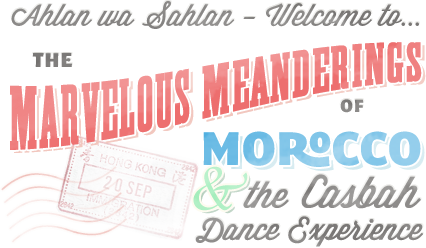
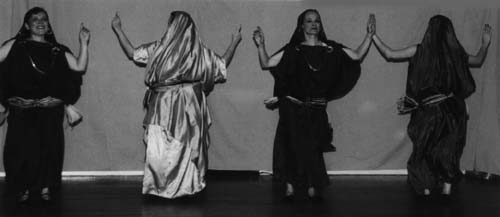 Tunisian women have a solidarity stronger than in most other countries. In many countries, the strongest bond is between the mother and her eldest son (because he is culturally obligated to take care of her, should anything happen …
Tunisian women have a solidarity stronger than in most other countries. In many countries, the strongest bond is between the mother and her eldest son (because he is culturally obligated to take care of her, should anything happen … 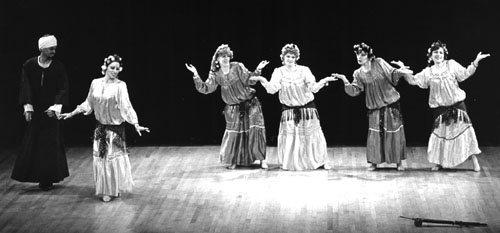 In Saidi or Upper Egyptian style, to a song made famous by Metkal Kenawi, the most beloved and well-known Saidi singer and rebaba player. Nowadays, his son sings more modern songs… This is a “tableau” or story dance …
In Saidi or Upper Egyptian style, to a song made famous by Metkal Kenawi, the most beloved and well-known Saidi singer and rebaba player. Nowadays, his son sings more modern songs… This is a “tableau” or story dance … 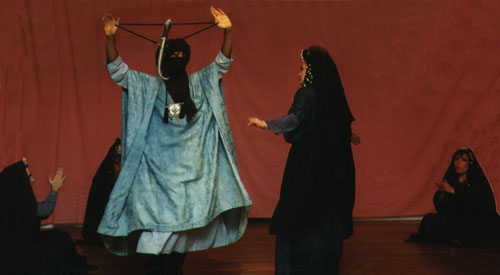 Trance ritual of the “Blue People” of the Sahara Desert, (from Mauritania through Morocco all the way to Egypt). Hands trace mystical symbols, spreading love & peace, thanking Earth, Water, Wind & Fire, blessing all present in spirit …
Trance ritual of the “Blue People” of the Sahara Desert, (from Mauritania through Morocco all the way to Egypt). Hands trace mystical symbols, spreading love & peace, thanking Earth, Water, Wind & Fire, blessing all present in spirit … 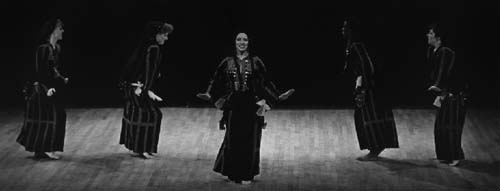 When done there “authentically”, it is performed by one heavily-veiled woman dancing before a line of clapping, chanting men (called “Keffafeen”), who do not dance at all, except for one man that the Haggala chooses from among them. …
When done there “authentically”, it is performed by one heavily-veiled woman dancing before a line of clapping, chanting men (called “Keffafeen”), who do not dance at all, except for one man that the Haggala chooses from among them. … 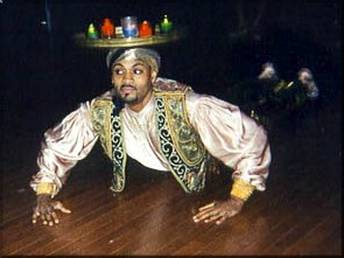 Making and serving mint tea is an integral part of Moroccan hospitality. The Tea Tray dance (Raks al Seniyya/ Danse du Plateau) is traditional, rather than folkloric. Like the Candelabrum Dance, it was started by an enterprising performer. …
Making and serving mint tea is an integral part of Moroccan hospitality. The Tea Tray dance (Raks al Seniyya/ Danse du Plateau) is traditional, rather than folkloric. Like the Candelabrum Dance, it was started by an enterprising performer. … 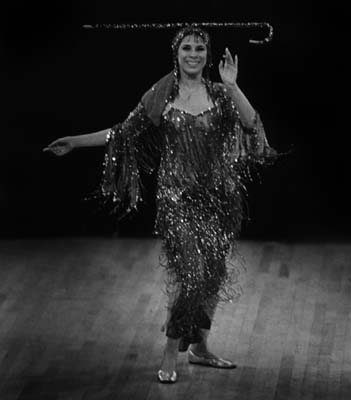 To show the dancer´s dexterity, balance, charm & highlight her hipwork. In Raqs al Assaya, although the woman dances with a masculine/macho symbol, in her hands it becomes transformed – feminine, flirtatious: “I can dance with your symbol. …
To show the dancer´s dexterity, balance, charm & highlight her hipwork. In Raqs al Assaya, although the woman dances with a masculine/macho symbol, in her hands it becomes transformed – feminine, flirtatious: “I can dance with your symbol. … 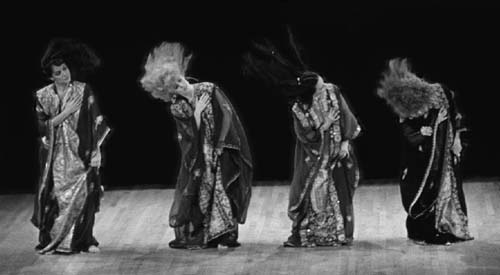 Raqs al Nasha’al /Raqs Samri is done at all-women Gulf parties, especially at weddings. It’s a Saudi/ Kuwaiti women’s dance where they used to wear special diaphanous overdresses full of gold sequins (thobe al nasha’al) and swirl their …
Raqs al Nasha’al /Raqs Samri is done at all-women Gulf parties, especially at weddings. It’s a Saudi/ Kuwaiti women’s dance where they used to wear special diaphanous overdresses full of gold sequins (thobe al nasha’al) and swirl their … 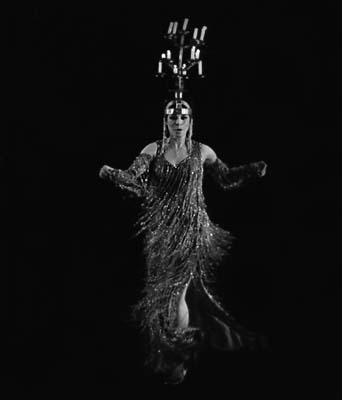 Before these too “conservative” times, it was a traditional dance, performed mostly at Egyptian weddings where the artist leads the bridal processional (zeffa) with a flaming candelabrum on her head to light the way of the happy couple, …
Before these too “conservative” times, it was a traditional dance, performed mostly at Egyptian weddings where the artist leads the bridal processional (zeffa) with a flaming candelabrum on her head to light the way of the happy couple, … 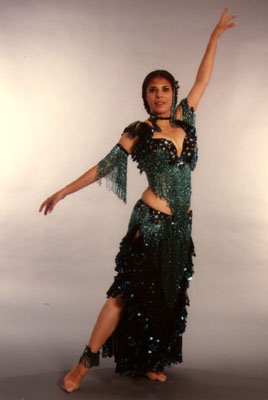 Over 3,000 years old, the faster parts of this beloved folk & social dance demonstrate the joy of life. Two of the slower movements imitate the movements of labor & childbirth. It is done by both sexes on …
Over 3,000 years old, the faster parts of this beloved folk & social dance demonstrate the joy of life. Two of the slower movements imitate the movements of labor & childbirth. It is done by both sexes on … 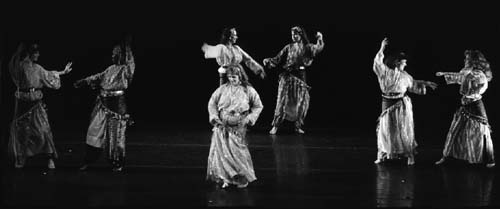 In Classical Arabic, sheikha is the feminine form of sheikh: a person of knowledge, experience, wisdom. Sheikha can mean a woman of knowledge and experience, the wife of the sheikh or both. In Darija (Moroccan Arabic), sheikha denotes …
In Classical Arabic, sheikha is the feminine form of sheikh: a person of knowledge, experience, wisdom. Sheikha can mean a woman of knowledge and experience, the wife of the sheikh or both. In Darija (Moroccan Arabic), sheikha denotes … 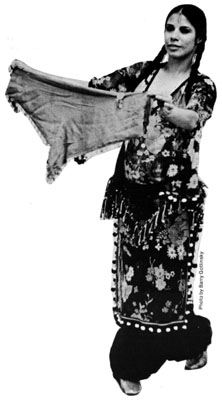 This urban Karsilama (9/8) of the poor, much-harrassed inner-city Istanbul Roma combines tableau elements with authentic dance movements. It is not your tambourine-shaking, skirt-flinging Hollywood fantasy – this Romany woman is “fed up” with dancing for tourists, but …
This urban Karsilama (9/8) of the poor, much-harrassed inner-city Istanbul Roma combines tableau elements with authentic dance movements. It is not your tambourine-shaking, skirt-flinging Hollywood fantasy – this Romany woman is “fed up” with dancing for tourists, but … 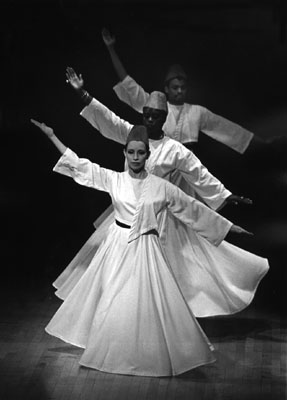 Jallaleddin al Rumi, known as Mevlaneh (teacher), was the founder of the Mevlevi sect of whirling dervish. Originally from Persia, he went to Turkey & today, the main Mevlevi mosque is in Konya, Turkey. The sect was much …
Jallaleddin al Rumi, known as Mevlaneh (teacher), was the founder of the Mevlevi sect of whirling dervish. Originally from Persia, he went to Turkey & today, the main Mevlevi mosque is in Konya, Turkey. The sect was much … 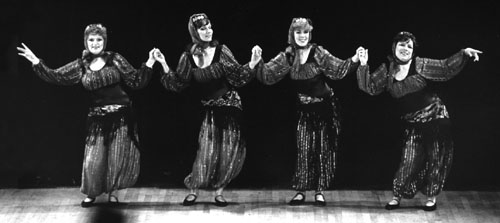 A combination of folkloric and “Oryantal” to the joyous 9/8 Karsilama rhythm. This is a “tableau”- a theatrical story-dance exercising artistic license and not a totally authentic folk dance. In this instance, three older, married sisters are surprised …
A combination of folkloric and “Oryantal” to the joyous 9/8 Karsilama rhythm. This is a “tableau”- a theatrical story-dance exercising artistic license and not a totally authentic folk dance. In this instance, three older, married sisters are surprised … 